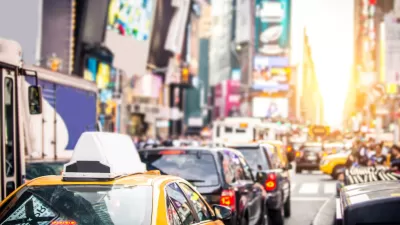Over the past couple of decades, Manhattan's ruthless redevelopment has transformed neighborhoods up and down the island. In the East Village, local leaders are trying to defend the area's popular dive bars from rising rents and changing clientele.
Laura Kusisto reports on efforts by local leaders to, "preserve the small watering holes the East Village is known for, as the
area becomes home to more large bars and clubs catering to young people
seeking a raucous night out." One avenue being considered is the creation of a special "night life" zoning district that would limit the location of clubs and large bars.
"As the neighborhood once known for its intimate night life is
transformed into what some deem a multi-block frat house," writes Kusisto, "community
leaders are looking for ways to control the scene that are more subtle
than simply quashing liquor-license applications."
"[Susan Stetzer, district manager for Community Board 3] said the community board isn't trying to stop new bars
from opening. Instead, board members are considering proposals to
concentrate them in areas away from residential buildings and
potentially restrict opening hours for some establishments. She said
this would help 'limit any negative quality of life impacts.'"
"It is unclear if limiting the location of bigger establishments would
necessarily save local favorites such as Lakeside Lounge, a 16-year-old
Alphabet City standby that closed in the spring, and Mars Bar, a
much-loved, proudly mangy dive that closed this year after 27 years, to
the chagrin of many neighborhood residents," notes Kusisto.
FULL STORY: Defining an East Village Bar

Trump Administration Could Effectively End Housing Voucher Program
Federal officials are eyeing major cuts to the Section 8 program that helps millions of low-income households pay rent.

Planetizen Federal Action Tracker
A weekly monitor of how Trump’s orders and actions are impacting planners and planning in America.

The 120 Year Old Tiny Home Villages That Sheltered San Francisco’s Earthquake Refugees
More than a century ago, San Francisco mobilized to house thousands of residents displaced by the 1906 earthquake. Could their strategy offer a model for the present?

HSR Reaches Key Settlement in Northern California City
The state’s high-speed rail authority reached an agreement with Millbrae, a key city on the train’s proposed route to San Francisco.

Washington State Legislature Passes Parking Reform Bill
A bill that would limit parking requirements for new developments is headed to the governor’s desk.

Missouri Law Would Ban Protections for Housing Voucher Users
A state law seeks to overturn source-of-income discrimination bans passed by several Missouri cities.
Urban Design for Planners 1: Software Tools
This six-course series explores essential urban design concepts using open source software and equips planners with the tools they need to participate fully in the urban design process.
Planning for Universal Design
Learn the tools for implementing Universal Design in planning regulations.
Ada County Highway District
Clanton & Associates, Inc.
Jessamine County Fiscal Court
Institute for Housing and Urban Development Studies (IHS)
City of Grandview
Harvard GSD Executive Education
Toledo-Lucas County Plan Commissions
Salt Lake City
NYU Wagner Graduate School of Public Service





























